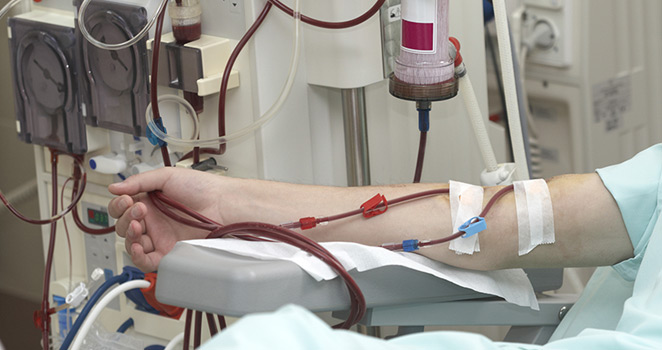Atrium Health Navicent Heart & Vascular Care
Dialysis and Other Vascular Access Procedures

What Is the Function of the Kidneys?
Your kidneys are organs that assist in filtering out impurities and excess fluid from your blood. They are also crucially involved in the production of blood cells and keeping bones healthy. If your kidneys malfunction, then harmful substances can fill the body. Hypertension can occur, and too much fluid can gather in your body's tissues. This can lead to swelling, also called edema. If your kidneys fail, then you can only resolve the problem with dialysis or a kidney transplant.
What Is Kidney Dialysis?
Dialysis is a treatment where a machine filters out the impurities and excess fluid from your blood. Dialysis replaces a number of the kidney's crucial functions.
There are different sorts of dialysis:
Hemodialysis - Your blood is filtered by a dialysis machine.
Peritoneal dialysis - Your blood is filtered inside the body after the abdomen is filled with a cleaning solution.
Hemodialysis
In hemodialysis, you will be connected to a machine that replaces the kidneys. The doctor creates something called a vascular access. This is an opening into one of the blood vessels.
During hemodialysis, your blood goes a little at a time through a filter in the machine. After the blood is cleaned, it is put back into the body. You may need treatment several times a week. The length of each session will depend on:
- How well your kidneys function
- How much fluid you have retained
- How much waste has collected in your blood
- How much you weigh
- The kind of machine used
Who Is a Candidate?
Dialysis is a required treatment for patients with end-stage kidney disease or kidney failure. You will require it if you have lost 85 percent to 90 percent of kidney function.
Other Vascular Access Procedures
Treatment for many kinds of conditions needs access to the body's blood vessels.
Different forms of access include:
Midline catheter - This type of access has features of both a standard IV and a primary access line. The nurse or physician inserts this line through a vein near the elbow. They then move it into a large vein in the upper arm. This kind of line is used for infusing certain kinds of medication.
Central catheters
This type of catheter gives access to large or primary vessels for use in infusing medications or nutrition. They are also used to allow the care team to measure vascular pressure.
Tunneled catheter
These catheters are large ones that are meant for frequent use and remain in their place for several months.
Subcutaneous port
Intermittent access to a vascular port, they may place a catheter into a vein and attach a small silicon reservoir to it. The whole device is implanted under the skin. This is used in such treatments as chemotherapy.
Dialysis port
Patients who are receiving dialysis need to have an access point in their forearm to provide access to the dialysis machine.
Vascular access keeps patients from requiring repeated venous punctures. Many times, access is needed on an ongoing basis. The approach is also needed for patients who have difficult IV access. The access point is also used for collecting blood samples. The lines are immediately ready for use after they are placed and easy to remove when their job is done.